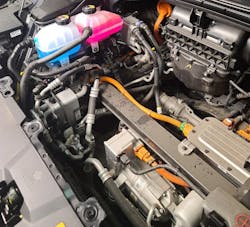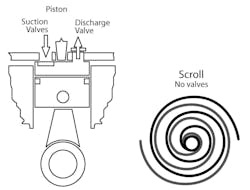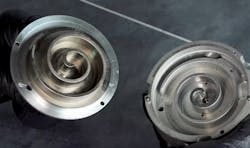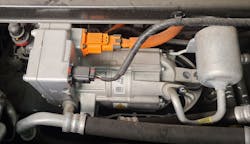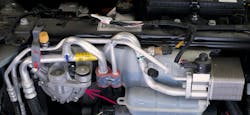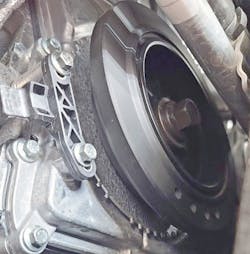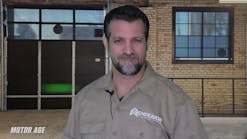The air conditioning (A/C) system in vehicles has provided essential comfort and convenience since its debut in 1939 by the Packard Motor Car Co. Before the rise of today's popular Hybrid Electric Vehicles (HEVs), Plug-In Hybrid Electric Vehicles (PHEVs), and fully Electric Vehicles (EVs), the Internal Combustion Engine (ICE) not only provided motive power but also supplied energy for nearly all the onboard systems, including the A/C compressor.
The traditional A/C compressor drew power from the crankshaft through a system of belts, pulleys, brackets, and tensioners.
Engineers already faced considerable challenges in achieving the best climate control with smaller displacement engines and start-stop features that limited ICE operation, but hybrid and fully electric vehicles present another ballgame all together.
The introduction of HEVs, PHEVs, and EVs revealed a significant drawback in the traditional ICE-powered, belt driven A/C compressor: it only works when the engine is running, and on EVs, there isn’t an engine at all. The last thing that automotive manufacturers want is uncomfortable drivers or passengers in their vehicles limiting A/C compressor operation when the vehicle is in start-stop mode.
To solve this major issue, a new generation of automotive A/C compressors powered by electricity, rather than a crank-belt-driven system, was developed. This led to the creation of the high-voltage electric A/C compressor.
The high-voltage electric A/C compressor is a significant advancement in automotive technology, compared to their ICE-driven counterparts. One major difference is that the electric A/C compressor can run at variable speeds, often controlled via Controller Area Network (CAN) protocols. This allows for optimal compressor speed and operation, resulting in the best climate control under various driving conditions.
The electric A/C compressor will use a scroll type compressor assembly, unlike conventional piston-based compressors. It works without valves, achieving nearly 100% volumetric efficiency. This high efficiency reduces the energy needed for A/C compressor operation, as there are no re-expansion losses typically associated with each piston stroke and the energy losses created by valves are eliminated.
Another advantage of electric A/C compressors is their ability to precisely control the compressor speed, using a brushless three-phase AC motor. This precise control optimizes energy consumption, thereby increasing the vehicle's overall range (something that is important to EV owners). Electric compressors are also more compact and lighter, resulting in weight savings of up to 20% compared to traditional ICE-powered compressors.
In the first generations of electric A/C compressors, distinct designs were employed, differing significantly from today's common electric A/C compressors. For instance, Honda used a dual scroll three-phase AC design that incorporated a traditional belt-driven scroll and an AC electrically driven scroll section. This design allowed for three separate phases of operation: combined operation of the belt and electrical scrolls for maximum cooling, belt-driven scroll only, and variable-speed electrical scroll operation only. Neither the belt-driven or electrical-driven parts of this A/C compressor could supply the needed maximum cooling alone, so when maximum cooling was requested by the operator, both sections would be in operation.
Another common feature of early electric A/C compressors was that the electric motor driving the A/C compressor was supplied with three-phase AC power via three heavy-duty cables from the vehicle's power inverter, or a dedicated A/C compressor driver/controller. However, this design is no longer common. Today's electric A/C compressors are supplied with high-voltage DC electrical power directly from the DC high-voltage battery system to an integrated power inverter, incorporated into the electric A/C compressor itself.
There are two main electric A/C compressor designs used today, depending on the location of the Power Inverter Module (PIM): top-mounted or rear-mounted, with the trend moving towards rear-mounted. When combined with a redesigned electric motor, this shift to a rear-mounted inverter reduces the compressor's length, width, and weight by about 10%.
The typical electric A/C compressor will have four separate sections: compressor section, motor section, PIM section and oil separator section. Each of these sections plays a significant part in the way that these compressors function.
Let’s examine each of these sections.
Compressor Section: This section handles drawing in, compressing, and discharging the refrigerant. The scroll A/C compressor will use a spirally wound fixed scroll and a rotating scroll (similar to the operation of a supercharger), which will compress the refrigerant by gradually wedging it into a smaller space as the scroll rotates. This scroll design offers significant advantages over traditional compressors.
The scroll design dramatically reduces noise and vibration. Unlike conventional piston-based compressors, which rely on reciprocating motion, the scroll compressor's continuous, smooth operation minimizes mechanical noise and vibration. This reduction in noise and vibration is particularly crucial in electric vehicles, which lack an internal combustion engine to mask these sounds with background noise.
The scroll mechanism also ensures a more consistent and steady compression process, leading to improved efficiency.
Motor Section: This section houses the DC brushless motor that drives the compressor, featuring a permanent magnet rotor and a coil stator. The three-phase brushless motor, typically controlled by a three-phase PIM, has windings with high-voltage insulation designed to withstand refrigerant oils. This setup enhances efficiency and torque output, crucial for compressor operation. With an output rating of 1.8-2.4kW, electric compressors are slightly less powerful than their ICE-belt-driven counterparts, which have ratings of 4.0-5.0kW.
Equipped with an eight-pole permanent magnet rotor, the typical three-phase electric A/C compressor achieves higher speeds and strong torque, essential for optimal performance. The stator windings, configured in a WYE formation, are connected to the PIM for operational control. Speed regulation is achieved through PIM current sensing on the WYE windings.
Power Invertor Module Section: Most electric compressors will integrate the PIM, streamlining high-voltage and control/communication connections and reducing wiring complexity. Alternatively, a remote-mounted PIM can supply the necessary three-phase high voltage through separate connections and cabling. The PIM houses electronics that power the compressor via six connection points, using transistor drive networks, including two Insulated Gate Bipolar Transistors (IGBT) per phase for control. The PIM controls the electric A/C compressor speed control through PWM (Pulse Width Modulation) of voltage output signals and current to the IGBTs, adjusting all three phases as needed to regulate compressor RPM. With the PIM mounted on the compressor body it provides the needed cooling to remove the heat from the electronics via the refrigerant passing into the compressor.
Higher current to the stator from IGBT controls results in increased motor torque, while the frequency of the control signal, measured in Hertz (Hz), determines motor speed, typically ranging from 0-50Hz (0-1,000 RPM) to around 375Hz (approximately 7,000 RPM). Manufacturer-specific variations may exist, such as the BMW i3's electric A/C compressor motor, which operates within a specific RPM range, allowing stepless adjustment within that range. For diagnostic purposes, symmetrical Hz patterns across the three phases are essential, especially when the PIM is remotely mounted. Some of the newest high-voltage electric A/C compressors will operate at 800V and can run continuously at 8,600 RPM. Electric scroll-type compressors maintain almost constant torque at any speed due to consistent compression, resulting in nearly constant electrical current. In addition to IGBT transistors, the PIM incorporates detection circuits for overload conditions and other critical parameters, ensuring operational safety and efficiency.
Oil Separator Section: In any air conditioning system, including those with electric compressors, lubricating oil is essential for ensuring the smooth operation of moving parts and preventing wear and tear. However, excess oil circulating in the refrigerant system can lead to various issues, such as reduced efficiency by impeding the heat transfer process within the system, decreased cooling capacity, and potential damage to components. The oil separator plays a crucial role in managing the distribution of oil within the system, ensuring that only the necessary amount of oil is present in critical areas, such as the compressor.
By effectively removing excess oil, the oil separator maintains optimal heat transfer properties, ensuring the A/C system operates at peak efficiency. This results in effective cooling, reduced energy consumption, and improved overall performance.
Diagnostics
Technicians must be mindful of significant differences when diagnosing an A/C system equipped with a high-voltage electric compressor, particularly in the case of HEVs, PHEVs and EVs. Unlike conventional ICE-equipped vehicles, where a malfunctioning compressor might result in partial or complete system bypass, the electric and hybrid vehicles heavily rely on air conditioning functionality. Neglecting to maintain the proper operation of the HVAC and electric A/C compressor can lead to excessive heating of critical components such as the high-voltage battery and electronics as the HVAC system is often used to remove this excess heat.
In the case of many new vehicles, especially HEVs, PHEVs, and EVs, the days of installing a bypass pulley, removing the drive belt, or not repairing the HVAC system will no longer be an option. The HVAC system and its components, especially the electric A/C compressor, are now considered a vital part. On a Tesla for example, which will be equipped with an electric A/C compressor, a failed A/C compressor could lead to an overheating high-voltage battery and that can activate safety measures that limit certain vehicle functions. Tesla employs advanced battery management systems to watch temperature, voltage, and charge status for safe battery operation. If the battery temperature exceeds safe levels, thermal management systems like cooling fans or liquid cooling are activated to dissipate heat. In severe cases, the onboard computer may take protective actions to prevent battery damage and ensure vehicle and occupant safety. These measures may involve reducing power output, temporarily disabling features, or even shutting down the vehicle until the battery cools down. Tesla vehicles prioritize safety with multiple layers of protection against battery overheating.
A Safety Reminder
Before we look at diagnostics on a high-voltage A/C compressor setup, we need to talk about safety. Because these systems function with high voltage and compressed refrigerant gas, we need to take certain precautions. It is imperative to understand the risks associated with high voltage. These vehicles are equipped with a high-voltage battery that is completely isolated from the chassis ground. Testing high voltage circuits should only be conducted using a DVOM and test leads with at least a Cat III rating. It cannot be emphasized enough that failure to adhere to the manufacturer's safety procedures could lead to severe injury or even loss of life.
Diagnosing a failure of a high-voltage electric A/C compressor will almost always involve the use of a scan tool and following the factory Diagnostic Trouble Code (DTC) procedures to repair the issue.
But many DTCs related to electric A/C compressor diagnostics can be intimidating when they are followed, as they will often not include any diagnostic steps other than the replacement of failed components named by the DTC.
For instance, a 2024 Chevrolet Silverado EV that has set a DTC P1C08 (A/C Compressor Motor Speed Too Low) and the MIL is illuminated. This DTC will set if the requested compressor feedback speed is less than 500 RPM for four seconds. The diagnostics for this code are as follows: ignition on, vehicle in service mode, scan, and if this code is set, replace the G1HV Air Conditioning with Motor Compressor. If after replacing the G1HV Air Conditioning with Motor Compressor the issue continues, and sets the same DTC, replace the K16 Battery Energy Control Module.
There is no diagnostic testing, no diagnostic circuit tests, no performance tests, just the installation of a new component.
But that doesn’t mean that we can’t do some testing. Because the electric A/C compressor uses high voltage, there are ways that we can inspect the three-phase motor that spins the compressor, and this can aid if we get specific codes that are related to an internal electrical compressor motor issue.
Most electric A/C compressors use an internal PIM for three-phase control. When testing, we can monitor the current used by the electric A/C compressor via the high-voltage DC input using an oscilloscope and a single DC current amp clamp. The in-rush current is typically four-to-six times the normal operating current, which lowers to a steady-state based on HVAC demands. After the compressor starts and stabilizes, we can check the current and examine the DC ripple in the waveform. Consistent and even ripples show good compressor health, while significant deviations may signal an internal issue in the stator, PIM electronics, or rotor. An electrical noise from the electric A/C compressor (think bad diode in an alternator) could indicate phase issues. Such issues often require replacing the entire compressor unit, except for Hyundai or Kia products, which allow separate replacement of either the compressor/motor/oil separator unit or the PIM assembly.
Hyundai and Kia have a diagnostic trouble tree test for non-operating electric compressors, guiding technicians through specific diagnostic steps. While heavily reliant on DTCs, non-trouble code diagnostics are also available. Hyundai provides a noise chart to diagnose compressor issues based on sound.
Hyundai and Kia also offer a self-diagnostic feature for the A/C system and electric A/C compressor that displays the stored DTCs on the climate graphic display. Activating self-diagnostic mode involves pressing a series of buttons on the dash.
Tesla offers an A/C Performance Test using the Service Mode on the center stack display and it should be noted that Tesla specifically wants the A/C systems desiccant bag changed at routine intervals.
Toyota provides a Refrigerant Gas Volume Check that will enable a scan tool to activate the electric compressor and perform a self-test on the system to verify that the correct volume of refrigerant is in the system, without the use of any gauges.
The amount of A/C refrigerant oil in this electric A/C compressor system is critical for proper operation. They hold little A/C refrigerant oil, and the compressor holds most of it. If replacing any components on the A/C system with an electric A/C compressor, following the manufacturer’s oil balancing procedure after a repair is important to ensure that the correct amount of A/C oil is installed to keep the system efficient.
The small amount of A/C oil in these systems can make leak detection difficult, if the tech is relying solely on the A/C refrigerant oil dye for leak detection. The combination of A/C oil dye and a good electronic leak detection is the preferred leak detection method.
Most systems already have a factory leak detection dye installed to help in leak detection. But if you are going to add leak detection dye to a system, make sure that the proper amount is used, and that the manufacturer supports the use of A/C dye. Certain Honda models equipped with electric A/C compressors and Nissans do not want any A/C dyes installed in their systems.
When servicing or replacing an electric A/C compressor, it is important to follow all the specific procedures that the manufacturer will spell out in their service information. New heat pump systems that use the electric A/C compressor can have many other valves and controls, which can hold pressurized refrigerant in the system even though the refrigerant gauge set may show that the system is empty. GM and VW, for example, have specific evacuation and fill procedures that use a scan tool to ensure the safe and correct removal and installation of refrigerant when service is required.
The use of the electric A/C compressor is a significant advance in automotive HVAC technology. Thanks to their variable speed control, compact size, and reduced noise, electric A/C compressors are poised to significantly impact the future of vehicle climate control. As automotive manufacturers increasingly prioritize efficiency and sustainability, electric compressors stand out as a key innovation in the electrification era. Their advanced design ensures a comfortable, quiet cabin, enhancing the driving experience and making them essential in modern electric and hybrid vehicles.
